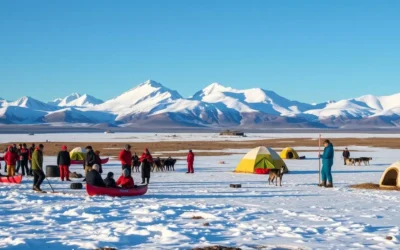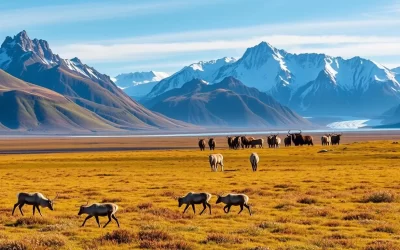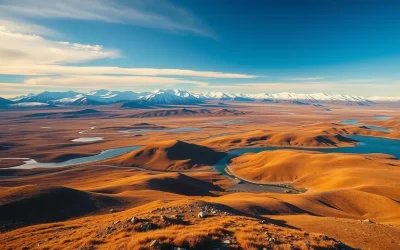✓ Accommodations✓ Flights✓ Rental Cars
Located on a small island in Frobisher Bay, about 12 kilometers from Iqaluit, lies a territorial park that offers a unique glimpse into Nunavut’s rich cultural heritage and natural beauty.
The park is situated on Qaummaarviit, which translates to “the place that shines,” a name that refers to the mica minerals in the rocks that make them glitter in the sunlight.
As one of the territory’s most accessible yet fascinating destinations, this park preserves over 750 years of Thule and Inuit history within its rocky landscape, making it an ideal place for visitors to explore.
This guide will take you through the top experiences to be had, from exploring traditional dwellings to spotting wildlife and enjoying seasonal activities.
Discovering Qaummaariit Territorial Park: Nunavut’s Hidden Gem
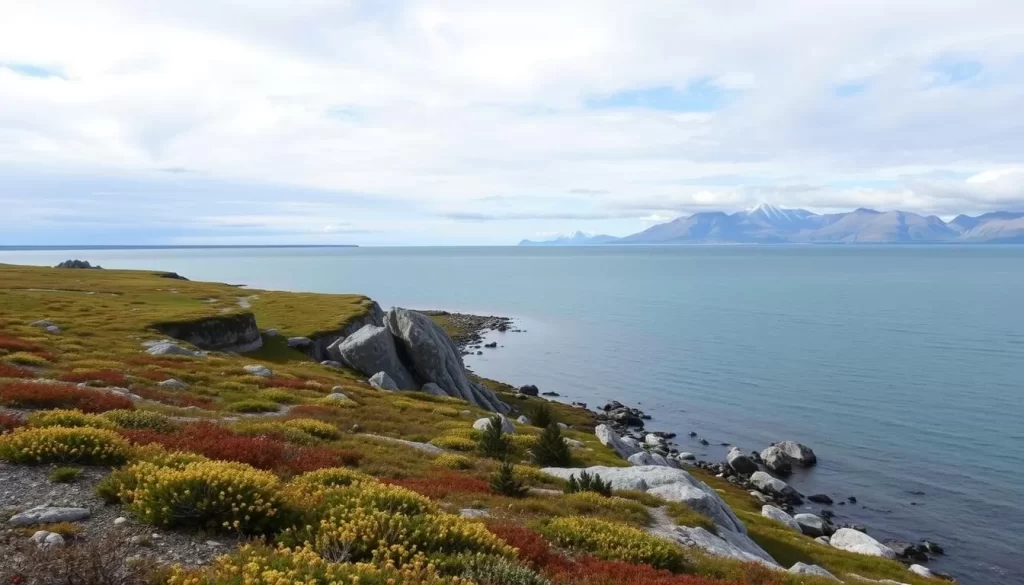
As you approach Qaummaariit Territorial Park, you’ll be drawn into a world where the Arctic landscape unfolds its secrets. Located on a small island in Frobisher Bay, about 12 kilometers from Iqaluit, this park is a unique experience that embodies the essence of Nunavut’s territory.
The Meaning Behind “The Place That Shines”
Qaummaarviit means “the place that shines,” a name derived from the mica-rich rocks that give the island its shimmering appearance. Historically, the glow from qulliit (traditional oil lamps) also guided Inuit travelers across the bay, adding to the island’s luminescent charm. This dual origin of its name highlights the park’s blend of natural beauty and cultural significance, making it a special place to explore.
Getting to Qaummaariit Territorial Park
Reaching Qaummaariit Territorial Park is an adventure in itself, with the journey varying by season. In winter, you can dogsled or snowmobile across the frozen bay, while summer offers the opportunity to boat or sea kayak to the island. This accessibility makes the park an ideal destination for those looking to experience the Arctic without venturing too far into the remote wilderness. As part of the Nunavut territory, the park is closely tied to the local community, preserving traditional knowledge and offering a glimpse into Inuit heritage.
The Rich Cultural Heritage of Qaummaariit Territorial Park
Qaummaariit Territorial Park is a treasure trove of Inuit history and culture, offering a glimpse into the lives of the Thule and Inuit peoples who inhabited the area for over 750 years. As you explore this significant site, you’ll uncover the deep-rooted traditions and ways of life that defined the Inuit community for generations.
750 Years of Thule and Inuit History
The area now known as Qaummaariit Territorial Park has been a vital part of traditional Inuit life for centuries, serving as a crucial camping site due to its proximity to prime hunting grounds. The park’s history is a testament to the resilience and adaptability of the Thule and Inuit peoples, who thrived in this challenging environment for over a year after year.
The strategic location allowed for seal hunting on the winter ice and caribou hunting on the nearby mainland, providing sustenance for the inhabitants. This enduring legacy is a significant part of the park’s inuit culture, reflecting the resourcefulness and ingenuity of its people.
Archaeological Treasures: Qarmait and Other Structures
The park is home to numerous archeological sites, including the remains of 11 qarmait, which were traditional semi-subterranean winter houses built using whale jawbones and ribs. These structures, covered in sealskins and insulated with snow blocks during winter, have been carefully restored by archaeologists, offering a unique glimpse into the lives of the Thule and Inuit peoples.
Visitors can explore these artifacts in their original context, gaining insight into the traditional ways of life and the community’s historical practices. Beyond the qarmait, the park contains tent rings, meat caches, and burial sites, all of which contribute to a comprehensive understanding of life in this region over the centuries.
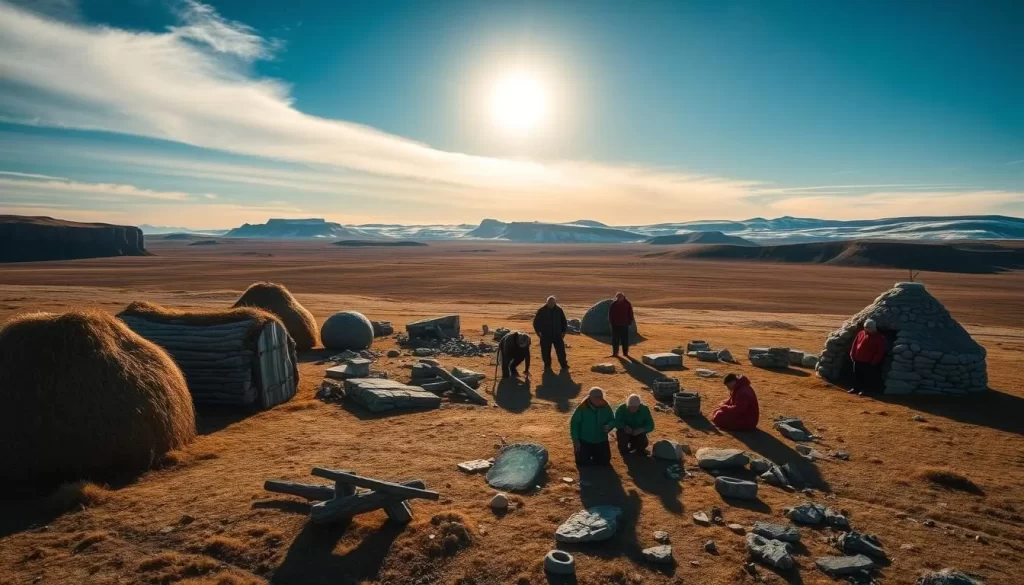
All archeological sites in Nunavut are protected under the Nunavut Archaeological and Paleontological Sites Regulations, emphasizing the importance of preserving this cultural heritage for future generations.
Top Things to Do in Qaummaariit Territorial Park, Nunavut
The beauty of Qaummaariit Territorial Park lies not just in its landscapes, but in the experiences it offers. As you explore this unique territorial park, you’ll discover a blend of cultural heritage and natural wonders that make for an unforgettable visit.
Exploring the Reconstructed Qarmaq
One of the highlights of visiting Qaummaariit Territorial Park is exploring the meticulously reconstructed qarmaq, built on the foundation of an original dwelling. This structure, supported by authentic whale jawbones and featuring a traditional sealskin roof, serves as a tangible connection to the past. You can step inside and imagine what daily life was like for the Inuit families who once called this island home. The qarmaq is not just a historical site; it’s an experience that brings history to life.
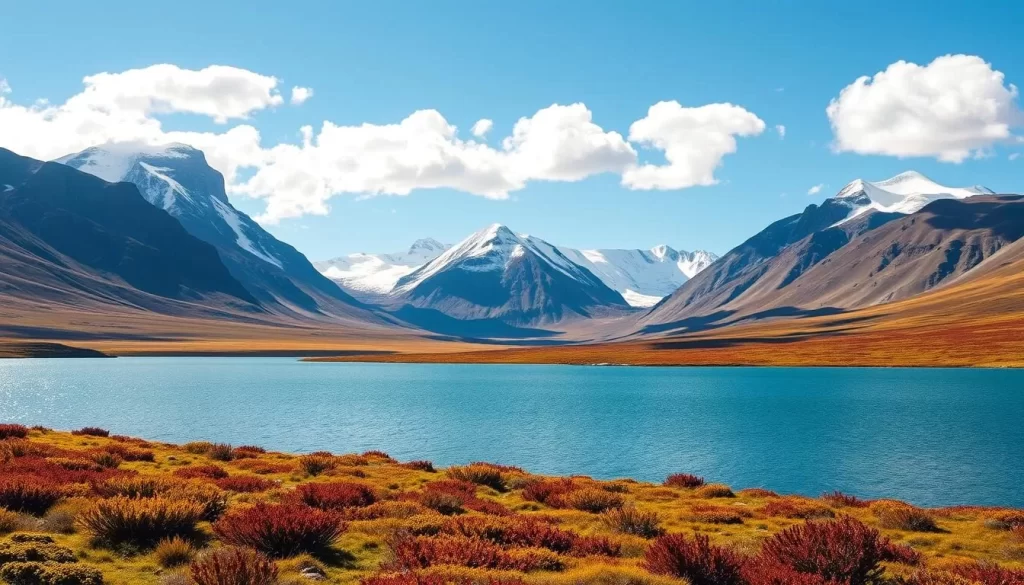
Walking the Boardwalk Trail System
The park’s thoughtfully designed trail system and boardwalks protect the fragile archaeological sites while guiding you through the landscape. Informative signage along the way explains the historical and cultural significance of various features, enriching your understanding of the area. This careful design allows you to appreciate the park’s natural beauty and cultural importance without causing harm to the sites.
Wildlife Viewing Opportunities
Despite its small size, Qaummaariit Territorial Park is a haven for wildlife enthusiasts. You can spot a variety of birds, including ravens, peregrine falcons, and long-tailed ducks, throughout the year. Seasonal visitors include Arctic foxes in the winter and migrating Baffin Island caribou in the summer, making every visit a unique experience in wildlife viewing.
Some of the top activities include:
- Exploring the reconstructed qarmaq to understand Inuit history and culture.
- Walking the boardwalk trail system to appreciate the park’s landscape and historical sites.
- Engaging in wildlife viewing to spot the diverse fauna that inhabit or visit the park.
Qaummaariit Territorial Park offers a compact yet rich experience that combines cultural immersion, gentle hiking, and wildlife observation, making it an ideal day trip from Iqaluit.
Seasonal Activities at Qaummaariit Territorial Park
Qaummaariit Territorial Park is a place where the changing seasons bring about distinct opportunities for adventure and exploration. The park transforms dramatically throughout the year, offering unique experiences that are heavily influenced by the season of your visit.
Winter Adventures: Dogsledding and Snowmobiling
In the winter, Qaummaariit Territorial Park becomes a winter wonderland, with Frobisher Bay turning into a frozen highway. This transformation enables you to reach the island via dogsledding or snowmobiling, offering a thrilling way to experience the park’s pristine landscape. Dogsledding provides a cultural connection to the traditional travel methods of the Inuit, while snowmobiling offers a faster-paced adventure across the ice. The frozen environment also creates opportunities for ice fishing and tracking wildlife in the snow, immersing you in the stark beauty and silence of Nunavut’s winter.
- Experience the thrill of dogsledding through the Arctic landscape.
- Explore the park’s winter scenery on a snowmobile, offering a faster-paced adventure.
- Try your hand at ice fishing, a unique winter activity in the park.

Summer Experiences: Boating and Sea Kayaking
As summer arrives, the ice retreats, and the waters around Qaummaariit Territorial Park become accessible for boating and sea kayaking. This allows you to approach the park from the water, much like the original inhabitants did. The warmer months are ideal for observing wildlife on the water, including belugas, ringed seals, and even bowhead whales. You can also enjoy fishing for Arctic char, a prized local species, making for a memorable trip.
- Explore the park’s coastline by boat, offering a unique perspective on its natural beauty.
- Paddle through the waters surrounding the island on a sea kayak, getting up close to marine wildlife.
- Enjoy fishing for Arctic char, a highlight of any summer trip to the park.
Natural Wonders of Qaummaariit Territorial Park
The park’s rugged landscape is home to an array of flora and fauna that have adapted to the harsh Arctic climate. As you explore the park, you’ll notice the unique features that make it an attractive destination for nature enthusiasts.
Flora: Arctic Poppies and Purple Saxifrage
Qaummaarviit Territorial Park’s flora is characterized by hardy grasses and colorful lichens that thrive in the rocky, hilly landscape. During the short growing season, the tundra bursts into color with delicate Arctic poppies and vibrant purple saxifrage. These flowers represent the resilience of life in the harsh northern climate.
| Category | Examples | Description |
|---|---|---|
| Flora | Arctic Poppies, Purple Saxifrage | Hardy plants that bloom during the short growing season |
| Marine Life | Belugas, Ringed Seals, Bowhead Whales | Varied marine wildlife that inhabits the waters around the park |
Marine Life: Belugas, Seals, and Bowhead Whales
The waters around Qaummaarviit are home to a variety of marine life, including belugas, ringed seals, and the occasional bowhead whale. These creatures not only represent the rich wildlife of the area but also highlight the connection between the natural and cultural heritage of the site. Visitors may catch a glimpse of these whales and other marine animals during their visit.
Essential Tips for Visiting Qaummaariit Territorial Park
A trip to Qaummaariit Territorial Park can be a lifetime experience if you are well-prepared and informed. As you plan your visit, it’s crucial to understand the importance of safety, respecting the environment, and preserving the park’s unique cultural heritage.
Safety in Bear Country
Qaummaariit Territorial Park is located in bear country, where polar bears and other bears can be encountered. To ensure your safety, it’s vital to stay alert and be prepared for potential bear encounters. When visiting the park, travel in groups when possible, make noise while walking to avoid surprising bears, and know what to do in case of a bear encounter. Consider carrying bear deterrents as an added precaution.
- Stay alert to your surroundings and watch for signs of bears.
- Travel in groups and make noise while walking.
- Know how to react during a bear encounter.
Respecting Archaeological Sites
The park is home to numerous archeological sites that are not only significant to the local culture but are also protected by law. Visitors must respect these sites by staying on designated trails and boardwalks, not touching or removing artifacts, and reporting any new finds to the park authorities.
| Dos | Don’ts |
|---|---|
| Stay on designated trails and boardwalks | Touch or remove artifacts |
| Report new archaeological finds | Disturb the natural environment |
Sustainable Travel Practices
To preserve the beauty and integrity of Qaummaariit Territorial Park, visitors are encouraged to adopt sustainable travel practices. This includes being prepared for variable weather conditions, minimizing your impact on the environment, and respecting wildlife. By following the “leave no trace” principle, you can help ensure that the park remains pristine for future generations.

By being mindful of your actions and their impact, you can enjoy a safe and fulfilling visit to Qaummaariit Territorial Park.
Conclusion: Why Qaummaariit Territorial Park Should Be on Your Nunavut Itinerary
For travelers to Nunavut, especially those based in Iqaluit, Qaummaariit Territorial Park is an unmissable experience. Located on a small island in Frobisher Bay, about 12 kilometers from Iqaluit, this park offers an accessible entry point to experiencing Nunavut’s rich cultural heritage and natural beauty.
Unlike some of Nunavut’s more remote national parks, such as Sirmilik National Park or Auyuittuq National Park, Qaummaariit can be visited as a day trip. This makes it an ideal destination for those who want to taste the Arctic experience without extensive wilderness travel preparations.
The park serves as an excellent complement to other Baffin Island attractions, offering a more intimate and culturally focused experience. For travelers interested in Indigenous history, Qaummaariit provides tangible connections to traditional Inuit life, enhancing understanding of the communities encountered throughout Nunavut.
While ambitious adventurers might dream of crossing the Arctic Circle on the Akshayunk Pass in Auyuittuq National Park or navigating the Northwest Passage, Qaummaariit offers a more accessible yet equally authentic way to connect with the land, history, and spirit of Nunavut. It’s a perfect addition to any northern itinerary, whether you’re a first-time visitor or a seasoned Arctic traveler.
In conclusion, Qaummaariit Territorial Park is a must-visit destination that combines cultural richness with natural beauty, making it an essential stop on your Nunavut journey.
The above is subject to change.
Check back often to TRAVEL.COM for the latest travel tips and deals.

